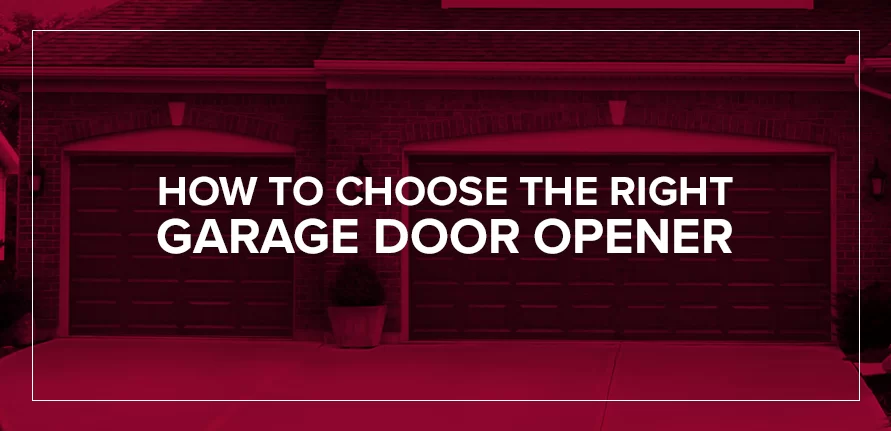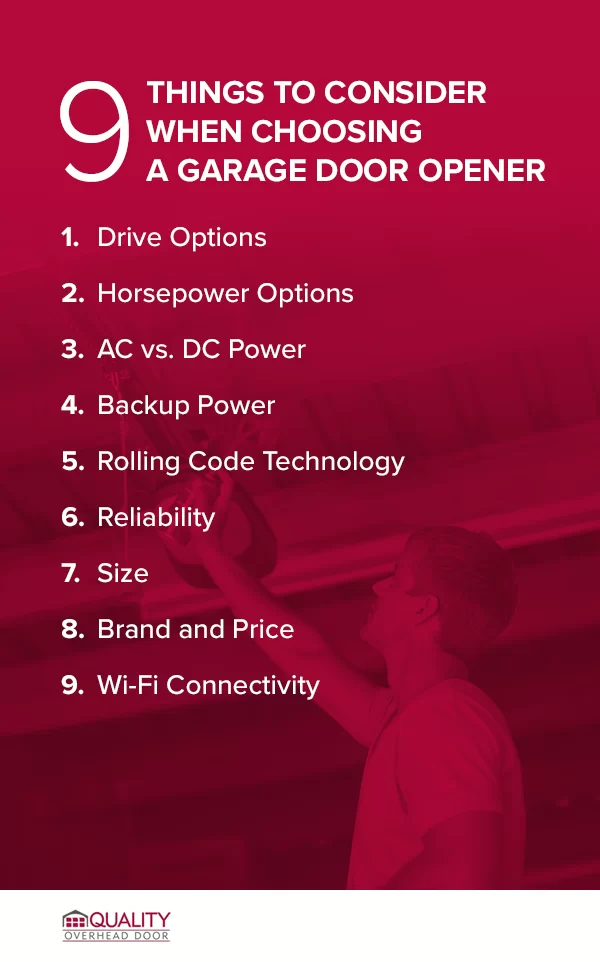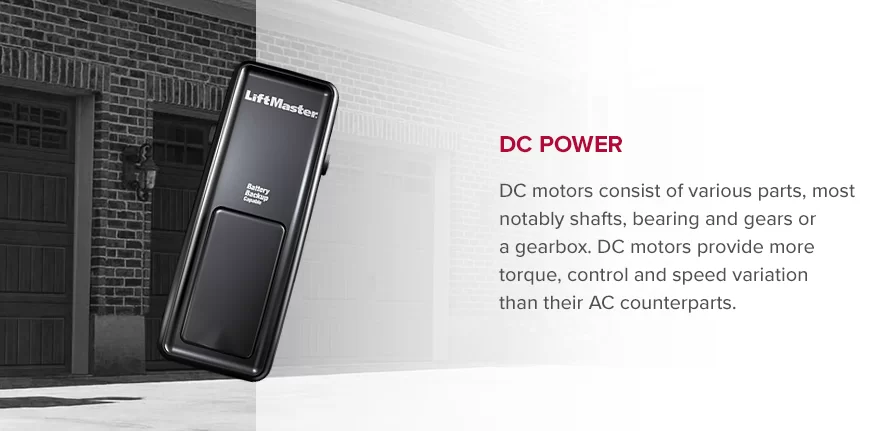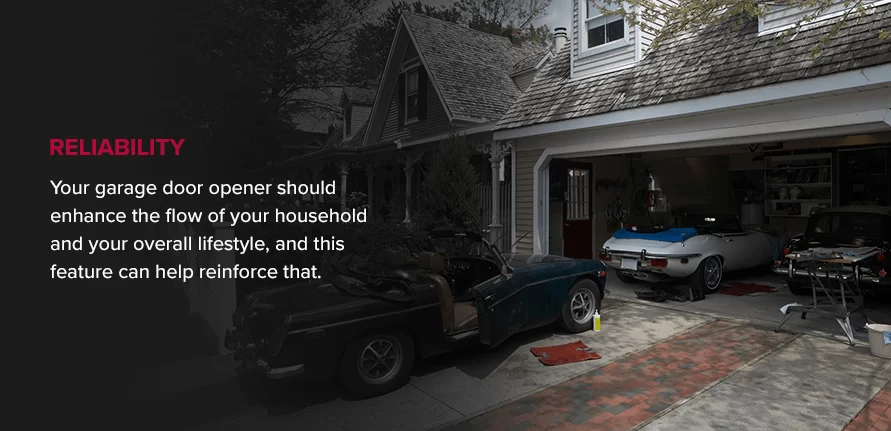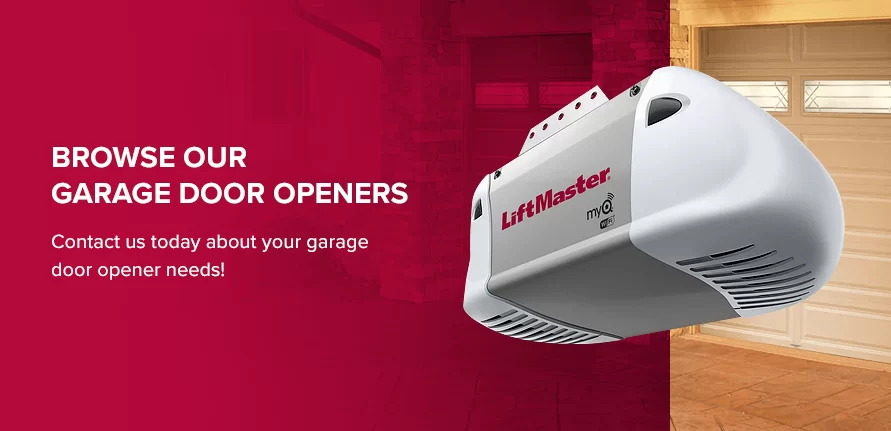Most homeowners may feel uncertain about what they want or need in a new garage door opener. You know to look for something that works reliably and delivers long-term value, but how do you make sense of the many options? The following is a guide on how to select a garage door opener, in which we’ll help you sort through the many options available on the garage door opener market.
9 Things to Consider When Choosing a Garage Door Opener
While all openers may open and close your garage door, they’re not all created equal. Some options are better than others in terms of durability, power, quiet operation, security, affordability and a variety of other factors. When selecting a garage door opener, consider each of the following:
1. Drive Options
Garage door openers generally share a similar design. They have a motor, which drives a carriage or trolley along a rail. This trolley is attached to the garage door, and when it moves, it pushes the garage door closed or pulls it open. The primary difference between different models of garage door openers is how the motor moves the trolley.
The three main types of garage door opener drives are chain, screw and belt:
- Chain: Chain-drive garage door openers use a metal chain to move the trolley that lifts or lowers the garage door. While chain-drive openers are affordable and durable, they tend to produce more vibrations and noises than other drive types. If your garage isn’t attached to your home, the noise might not be an issue. But if your garage is next to a bedroom, a quieter option may be the way to go.
- Screw: Screw-drive openers use threaded steel rods to push the trolley. When the rod is in rotation, it pushes the lifting mechanism along its track to lift or lower the garage door. Screw-drive openers generally make less noise than their chain-drive counterparts and require less maintenance due to their relatively few moving parts. However, they can be a bit pricier than chain drives.
- Belt: Belt-drive openers function in a similar fashion to chain-drive systems, but instead of a chain, they use a belt to drive the trolley. The belt allows the openers to operate more quietly and smoothly than screw- or chain-driven systems. If there’s a bedroom or living space next to your garage, a belt drive is probably the best option. Belt drives tend to be the most expensive of the three drive types.
2. Horsepower Options
You’ll also encounter a range of horsepower options. To determine which horsepower you require, you should first consider the size and weight of your garage door. Depending on the door’s material and whether it’s a single or double door, the weight can vary. Your door’s weight and opener’s horsepower need to match up for optimal operation.
You should also consider the longevity you’d prefer for your opener. Some people decide to buy a lower-horsepower motor at a lower price and replace it after a shorter length of time. Other people opt for a more expensive, higher-horsepower motor that will work dependably for many years. It depends on which investment you’d like to make.
The three horsepower options for residential doors include:
- 1/3 horsepower: While affordable, 1/3-horsepower motors generally do not last as long as openers with 1/2 horsepower and 3/4 horsepower. They perform fairly well with lighter doors, like those made out of steel, but they may not last very long in general. Technically, they’re able to lift any doors with weights that are evenly distributed, but combining a 1/3-horsepower opener with a heavy door means you’ll have to replace it more frequently than if you opt for an opener with greater horsepower.
- 1/2 horsepower: As the most common of the three horsepower options, 1/2-horsepower openers perform best with single and double doors of a moderate weight. This is the middle-of-the-road option in terms of power and price, so it’s suitable for a wide variety of garage doors.
- 3/4 horsepower: Certain types of garage doors, like wood garage doors, are often very heavy. These doors, as well as any doors wider than 14 feet, typically need a 3/4-horsepower opener if you want it to work for many years to come. Although the priciest option, 3/4-horsepower openers last a long time and provide the most power.
Whichever option you choose, it is critical that your door is always balanced properly. Regardless of the horsepower of your opener, if your door is unbalanced, there will be problems.
3. AC vs. DC Power
Another decision you will have to make is whether you want an opener with AC or DC power. While both are designed to perform the same function — which is to transform electricity into motion — they do this in different ways. We’ll discuss the differences between each type below:
AC Power
In AC motors, energy comes from magnetic fields, which are generated through coils that are wrapped around the output shaft. These motors are comprised of several components, including a rotor and a stator. In general, AC motors are durable, efficient and flexible.
Garage door openers with AC motors can be characterized by the following:
- They’re less expensive.
- They’re more durable and require little maintenance.
- They’re more likely to feature a chain drive.
DC Power
DC motors get their power from batteries or another generated source of power that provides constant voltage. DC motors consist of various parts, most notably shafts, bearing and gears or a gearbox. DC motors provide more torque, control and speed variation than their AC counterparts.
Garage door openers with DC motors have the following characteristics:
- They’re more expensive.
- They use less energy than AC motors.
- They’re more likely to feature a belt drive.
- They can vary the speed at which they start the process of opening and stop the process of closing, which is gentler on the door.
- They’re quieter, with some models being virtually undetectable from inside your house when they’re in motion.
- They can reverse more smoothly and quickly than AC-powered openers.
- They have battery backup capabilities in case the power goes out. This isn’t possible with AC-powered openers due to the large amount of power they need to operate.
4. Backup Power
You want to have a garage door opener that continues to function if the power goes out. Garage door openers are equipped with at least one of the following:
- Manual release: This important feature allows the user to disconnect the opener from the garage door, giving them the ability to open it manually. Although a garage door is very heavy, its spring system offers sufficient counterbalance so an adult has no trouble opening it. In addition to its usefulness during an outage, this manual release feature also serves as a useful diagnostic tool when determining whether your garage door is balanced properly.
- Battery backup: Battery backups are an alternative way for you to use your garage door when the power goes out temporarily. While you can only use your battery backup a limited number of times during an outage, if you ration your use well, the battery backup will keep your garage door working during an extended power outage. When the power comes back on, the battery backup will start charging up again.
5. Rolling Code Technology
If you are interested in added safety and security, consider rolling code technology. In days past, it was possible for a neighbor to have the same exact garage door code as yours. Today, garage door openers with rolling code technology create a new and secure code from among billions of options each time you use the garage door.
6. Reliability
You need to be able to depend on your garage door opener, both for convenience and safety. Check to see if your garage door opener options offer dual-frequency signals. This helps minimize interference from other garage door openers — ensuring you always have the access you need. Your garage door opener should enhance the flow of your household and your overall lifestyle, and this feature can help reinforce that.
7. Size
Standard garage doors are 7-feet high. Because of this standard height, garage door openers are designed to fit 7-foot garage doors. If you have a non-standard door size, make sure you understand the costs related to modifying a particular garage door opener option before you make a final purchase.
8. Brand and Price
Only you know how much you can afford to spend on a new garage door opener. Know your budget going into the process, and stick to those parameters. Perhaps you have loyalty to a specific brand you’ve used before, which is great. Be sure to stick with a trusted brand name that’s proven to deliver the quality and durability you want in a garage door opener. You can find bargain garage door openers that promote many features at a low price, but like with many appliances, you get what you pay for with a garage door opener.
9. Wi-Fi Connectivity
Smart garage door openers are ones you can monitor and control remotely from your phone by connecting them to your home’s Wi-Fi. These advanced openers also provide the following benefits:
- Accessible monitoring: With your smartphone or another smart device, you can easily check in on your garage door’s activity. For instance, you can find out whether you accidentally left your door open and receive alerts in real time whenever your garage door is opened or closed.
- Accessible control: You can also control the movements of your garage door from anywhere in the world. For example, you could let your dog walker into your house while you’re away on vacation or allow guests to access your home. You can also schedule times for your door to open or close.
- Simple setup: If you’ve never used a smart garage door opener, it may appear complicated to set up, but it’s actually fairly intuitive. Just follow the basic instructions to connect your opener to the Wi-Fi connection in your home, then download the myQ app to your Apple or Android device. With this app, you can monitor and control your door from anywhere.
- Seamless integration: The myQ app allows you to monitor your garage door right alongside your home security system. That’s right — with this app, you can link a smart garage door opener to Wink, Nest, Apple HomeKit and Xfinity Home.
Clunky garage door opener remotes can be difficult to keep track of, which may tempt you to do away with the remote and just control your door using your app. While the app is needed to operate and monitor your garage door remotely, it may be best not to think of your smartphone as a replacement for your remote. The app isn’t meant to be used for regular opening and closing of your garage door, and the process takes longer than pressing the button on your remote.
Tips on How to Choose a Compatible Garage Door Opener
When shopping for a garage door opener, the layout of your house can also help determine which one you buy. For instance, is your garage adjacent to a living room or bedroom? If so, you may want your opener to operate as quietly as possible, which means you should opt for a belt-drive garage door opener.
Some other useful tips include:
- Consider the lighting in your garage: Would your garage benefit from the safety and convenience of motion-sensor lighting? If so, you may want to think about getting an opener that has a wall button with a motion detector.
- Think about the configuration of your garage door: If you have more than one garage door, pick an opener model that has a three-button transmitter, which allows you to operate each door separately. Under no circumstances should you try to use a single opener to operate more than one door at once.
- Get a rail that fits the height of your door: If the height of your door is extended, make sure you get the appropriate rail length. Residential rails are available for doors that are 7 feet, 8 feet and 10 feet high.
- Don’t be fooled by garage door openers that advertise legally required features: Some openers advertise lowering 7 inches per second or highlight automatic reverse mechanisms, but these safety features are required by law and all garage door openers have them.
Browse Our Garage Door Openers
At Quality Overhead Door, we specialize in providing outstanding products and exceptional customer service to home and business owners in the Toledo area. Contact us today about your garage door opener needs!
Additional Resources on Garage Door Openers:
- How do Garage Door Openers Work
- How to Connect Your Garage Door Opener to WI-FI
- How to Program a LiftMaster Garage Door Opener
- Overhead vs. Wall Mount Garage Door Openers

